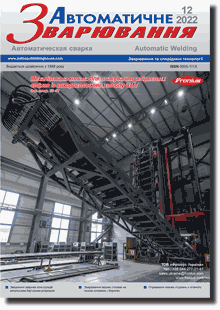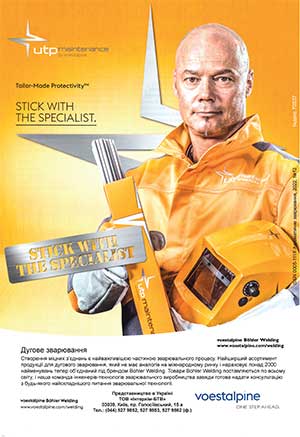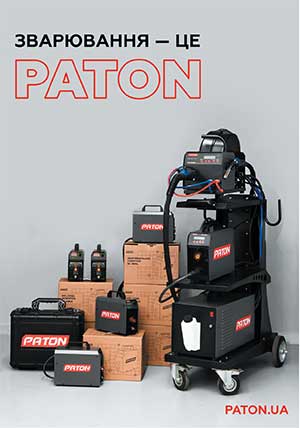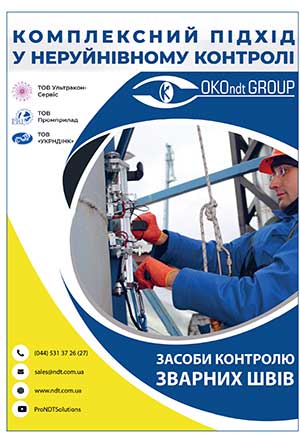| 2022 №12 (03) |
DOI of Article 10.37434/as2022.12.04 |
2022 №12 (05) |

"Avtomatychne Zvaryuvannya" (Automatic Welding), #12, 2022, pp. 28-37
Producing nitinol brazed joints (Review)
S.V. Maksymova, B.V. Stefaniv
E.O. Paton Electric Welding Institute of the NAS of Ukraine. 11 Kazymyr Malevych Str., 03150, Kyiv, Ukraine. E-mail: office@paton.kiev.uaShape-memory alloys are becoming ever wider applied in different industries, in particular in aerospace, medical, automotive sectors and in consumer electronics manufacturing. Application of these materials as hybrid structure elements is a promising direction when creating products with a unique set of properties: high mechanical values, superplasticity, damping ability, higher wear resistance and thermomechanical memory. Production of nitinol permanent joints by welding leads to formation brittle phases of Ti2Ni type, which degrade the product quality. This review discusses the possibility of producing high-strength permanent joints of nitinol with nitinol and with other alloys by brazing. The main advantage, compared to other methods, is the fact that base metals do not melt, and some structural transformations can be avoided. At nitinol brazing in ambient air, brazing filler metals of Ag–Cu–Zn-Sn–Ni system haven proven themselves well, using 25AgCl–25KF–50LiCI flux. We should specially mention application of silver brazing filler metals and interlayers from pure metals, for instance, niobium, providing a strong metallurgical bond with the base metal. At brazing temperature of 1180 °С an alloy based on quasibinary NiTi–Nb eutectic system is formed, ensuring the reliability of brazed elements when creating prototypes of superplastic honeycomb shapes from titanium nickelide. 32 Ref., 4 Tabl., 8 Fig.
Keywords: titanium nickelide (nitinol), shape memory alloys (SMA), brazing filler metals, brazing, welding, wetting, intermetallic brittle compounds, strength, structure
Received: 27.10.2022
References
1. Paton, B.E., Kaleko, D.M., Shevchenko, V.P. et al. (2006) Weldability of shape-memory alloys of Ni-Ti system. The Paton Welding J., 5, 1-10.2. Jani, J.M., Leary, M., Subic, A.R, Gibson, M.A. (2014) A review of shape memory alloy research, applications and opportunities. Materials & Design, 56, 1078-1113. https://doi.org/10.1016/j.matdes.2013.11.084
3. Krasovsky, V.P. (2009) Study of capillary characteristics and melting of nickel-titanium alloy (NiTiNOL) with shape-memory effect. Adgeziya Rozplaviv i Payanniya Materialiv, 42, 95-102 [in Ukrainian].
4. Akimov, O.V., Nuri, S.M. (2015) Alloys with shape-memory effect. History of emergence and development, physics of process of their unique properties. Visnyk NTU KhPI, 14 (1123), Series: New Solutions in Modern Technologies, 42- 49 [in Russian].
5. Tillmann, W., Eilers, A., Henning, T. (2021) Vacuum brazing and heat treatment of NiTi shape memory alloys. IOP Conf. Series: Materials Science and Engineering 1147:012025. https://doi.org/10.1088/1757-899X/1147/1/012025
6. Razorenov, S.V., Garkushin, G.V., Kanel, G.I. et al. (2011) Behavior of nickel-titanium alloys with effect shape memory under shock-wave loading. Physics of the Solid State, 53, 4, 768-773 [in Rissian]. https://doi.org/10.1134/S1063783411040305
7. Massalski, T.B. (1990) Вinary Alloy Phase Diagrams, American Society for metals. (Ohiо: Metals Park: ASM International: СD).
8. Blednova, Zh.M., Stepanenko, M.A. (2012) Role of alloys with shape-memory effect in modern mechanical engineering. Krasnodar, RF [in Russian].
9. Chau, E.T.F. (2007) А Comparative study of joining methods for a SMART aerospace application. Eng. doctorate thesis. Cranfield University, UK.
10. Senkevich, K.S. (2017) Prospects of producing and application of hybrid structures and composites of titanium alloys and nitinol: Review. Izv. Vuzov. Poroshk. Metallurgiya i Funktsionalnye Pokrytiya, 4, 71-78 [in Russian]. https://doi.org/10.17073/1997-308X-2017-4-71-78
11. Zoeram, A.S., Mousavi, A. (2014) Laser welding of Ti-6Al- 4V to nitinol. Mater. Desig, 61, 185-190. https://doi.org/10.1016/j.matdes.2014.04.078
12. Akselsen, O.M. (2010) Joining of shape memory alloys. Shape Memory Alloys. SINTEF Materials and Chemistry, Ed. by Cismasin, C. InTech, Norway, 183-211.
13. Shiue, R.H., Wu, S.K. (2006) Infrared brazing of Ti50Ni50 shape memory alloy using gold- based braze alloys. Gold Bull., 39, 200-204. https://doi.org/10.1007/BF03215554
14. Grummon, D.S., Shaw, J.A., Foltz, J. (2006) Fabrication of cellular shape memory alloy materials by reactive eutectic brazing using niobium. Mater. Sci. Eng., A 438-440, 1113-1118. https://doi.org/10.1016/j.msea.2006.03.113
15. Zhao, X.K., Tang, J.W., Lan, L. et al. (2009) Vacuum brazing of NiTi alloy by AgCu eutectic filler. Mater. Sci. Technol., 25, 1495-1497. https://doi.org/10.1179/174328409X405625
16. ASM Handbook: Alloy Phase Diagrams, 3, 1992, ASM International, Metals Park, Ohio, USA.
17. Tang, W., Sandstrom, R., Miyazaki, S. (2000) Phase Equilibria in the Pseudobinary Ti0.5Ni0.5-Ti0.5Cu0.5 System. J. of Phase Equilibria, Japan, 21(3), 227-234. https://doi.org/10.1361/105497100770340020
18. Watanabe, T, Sonobe, H. (1992) Brazing of Ni-Ti Type Shape Memory Alloy. Quarterly Journal of the Japan Welding Society, Japan, 10, 1, 95-101. https://doi.org/10.2207/qjjws.10.95
19. Shiue, R.K., Wu, S.-K. (2005) Infrared brazing Ti50Ni50 and Ti-6Al-4V using the BAg-8 Braze alloy. Mater. Trans., 46 (9), 2057-2066. https://doi.org/10.2320/matertrans.46.2057
20. Li, M.G., Sun, D.Q., Qiu, X.M. et al. (2006) Effects of laser brazing parameters on microstructure and properties of TiNi shape memory alloy and stainless steel joint. Mater. Sci. Eng. A, 424 (1-2), 17-22 https://doi.org/10.1016/j.msea.2006.01.054
21. Lin, C., Shiue, R.K., Wu, S.-K, Yang, T.-E. (2019) Infrared Brazed Joints of Ti50Ni50 Shape Memory Alloy and Ti-15-3 Alloy Using Two Ag-Based Fillers. Materials, 12, 1603-1614. https://doi.org/10.3390/ma12101603
22. Qiu, X.M., Li, M.G., Sun, D.Q., Liu, W.H. (2006) Study on brazing of TiNi shape memory alloy with stainless steels. J. Mater. Proc. Technol., 176, 8-12. https://doi.org/10.1016/j.jmatprotec.2005.06.004
23. Humpston, G., Jacobson, D.M. (2004) Principles of Soldering. ASM International® Materials Park, Ohio, USA. https://doi.org/10.31399/asm.tb.ps.9781627083522
24. Shiue, R.K., Wu, S.K., Chen, S.Y. (2003) Infrared brazing of TiAl intermetallic using BAg-8 braze alloy. Acta Materialia, 51, 1991-2004. https://doi.org/10.1016/S1359-6454(02)00606-7
25. Bewerse, C, Brinson, L.C., Dunand, D.C. (2015) Microstructure and mechanical properties of ascast quasibinary NiTi-Nb eutectic alloy. Mater. Sci. Eng. A, 627, 360-368. https://doi.org/10.1016/j.msea.2014.12.090
26. Piao, M, Miyazaki, S, Otsuka, K., Nishida, N. (1992) Effects of Nb addition on the microstructure of Ti-Ni alloys. Mater. Trans., 33, 337-345. https://doi.org/10.2320/matertrans1989.33.337
27. Wang, Y., Cai, X.Q., Yang, Z.W. et al. (2017) Effects of Nb content in Ti-Ni-Nb brazing alloys on the microstructure and mechanical properties of Ti-22Al-25Nb alloy brazed joints. J. Mater. Sci. Technol., 33, 682-689. https://doi.org/10.1016/j.jmst.2017.03.021
28. Liu, S., Han, S., Wang, L. et al. (2019) Effects of Nb on the Microstructure and Compressive Properties of an As-Cast Ni44Ti44Nb12 Eutectic Alloy, Materials, 12, 4118. https://doi.org/10.3390/ma12244118
29. Wang, L., Wang, C., Zhang, L.C. et al. (2016) Phase transformation and deformation behavior of NiTi-Nb eutectic joined NiTi wires. Scientific Reports. 6:23905. DOI: 10.1038/ srep23905 https://doi.org/10.1038/srep23905
30. Grummon, D.S., Low, K.-B. Foltz, J., Shaw, J. (2007) New Method for Brazing Nitinol Based on the Quasibinary TiNi- Nb System. In: Proc. of 48th Conf. on AIAA/ASME/ASCE/ AHS/ASC Structures, Structural Dynamics, and Materials (Honolulu, Hawaii, 23-26 April 2007). https://doi.org/10.2514/6.2007-1741
31. Low, K.B. (2009) Reactive eutectic brazing of nitinol. Ph.D. Thesis, Michigan State University, USA.
32. Satoh, G., Brandal, G., Naveed, S., Yao, Y.L. (2017) Laser Autogenous Brazing of Biocompatible, Dissimilar Metals in Tubular Geometries J. Manuf. Sci. Eng., 139 (4), 041016, 1-16. https://doi.org/10.1115/1.4035034




